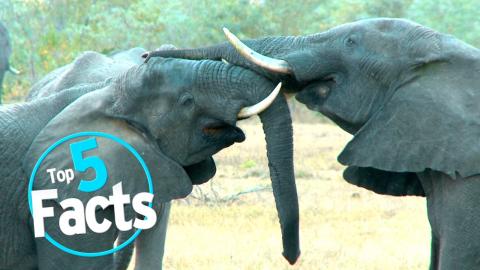Top 5 Hard-Hitting Zoo Facts

For the average family, a trip to the zoo leads to a greater understanding of the animal kingdom. But that conversation is limited to just human beings. Welcome to WatchMojo's Top 5 Facts. In today's installment, we're counting the Top 5 most interesting and somewhat damning facts that you probably didn't know about zoos.
Special thanks to our users speechjon or submitting the idea using our interactive suggestion tool at http://www.WatchMojo.comsuggest
#5: Elephants Adapt Poorly to Zoo Life
In the wild, the primary goal is survival. So with the necessities of survival providing for them in zoos, you might expect animals to have, on average, longer lifespans in zoos. And you’d be right! Many animals, including dolphins and tigers tend to have longer lives in zoos than in the wild. But zoo life can be especially hazardous for wild elephants forced into captivity. In fact, according to some published research, African elephants typically reach their 50s out in the wild, as compared to a predicted life span of 17 years when born inside a zoo. There’s no clear-cut reason for this, but researchers have noted that 40 percent of African elephants in zoos are obese. More research is needed on the cause and effects of this surplus weight, but it’s clear that something is detrimentally affecting the formative years of elephants while caged up.
#4: There Sure Are Some Zany and Horrible Zoos in China
China, a land with millenia of cultural history, but also the place where unlicensed attractions like this Disneyland knockoff can somehow exist. Have you ever heard of boxing bear cubs wearing capes? Well, this happened at a Xi’an zoo in 2007. And then there’s the Xiongsen Tiger and Bear Park, which is reportedly just a front for making tiger bone wine. But at least they do have actual tigers and bears– a zoo in China’s Henan Province misrepresented their animals entirely, ranging from a Tibetan Mastiff posed as African Lion and other dogs portraying leopards. Of course, just as Shanghai now has its own bona fide Disney theme park, China also has some legit zoos. These instances of animal abuse in China received some attention because they are kind of wacky, but less interesting, downright tragic forms of neglect and abuse are quietly reported at various zoos around the world.
#3: Animal Relocation Disrupts Pack Units
Zoos, like another other tourist destination, will often advertise new attractions. This often means they’ve just taken custody of a new animal, probably from another zoo. Animals are often shipped from one zoo to another either for mating purposes, or just for straight up marketing purposes. Just as humans will grieve when taken away from their family, the same goes for pack units in zoos. Many animals, particularly primates, have complex social structures and don’t take kindly to the introduction of outsiders. While overt symptoms of anxiety can be clear, it’s often no easy task to gauge the severity of depression in zoo animals removed from their pack units.
#2: Drug Lords Like Having Their own Zoos
In the 1980s, cocaine kingpin Pablo Escobar famously imported all kinds of animals to his ranch near Medellin, Colombia. Apparently, he started a trend. In 2011, approximately 5,500 animals were seized from zoos owned by Mexican gangs. While Escobar bought some animals from the San Diego Zoo, many others are purchased on the black market, often arriving there via “cubnapping.” This is a practice in which animals are stolen from zoos at young ages when they are less inclined to act out. Not only does “cubnapping” lead to even more psychological damage to the animals in question, but the whole unsanctioned illegal zoo concept can introduce invasive species into ecosystems; the largest herd of hippos outside of Africa now haunt the village and countryside near Escobar’s old ranch.
#1: Zoos + Psychosis = Zoochosis
Despite the best efforts of zoos and dedicated zookeepers that take proper care of the inhabitants, and despite whatever benefits zoos might ultimately have, wild animals were not meant to be caged up. And it’s this confinement that leads to “zoochosis.” It’s impossible to gauge the levels of depression, but the anxiety stems from the disruption of the animals’ normal lives. It’s not uncommon for humans to gawk at so-called “funny” behavior– like bears who pace back and forth endlessly, or predators who lash out at visitors behind glass walls– but these behaviors are often signs of severe emotional damage. And so, if toys and puzzles don’t settle down zoo animals, they are treated with a whole range of psychopharmaceuticals: Zoloft, Prozac, Haldol, Xanax, Valium… You name it, there’s a case of zoochosis that’s been treated by it.
So, what fact surprises you the most? Do you think zoos do more good than harm? For more kingpin top 10s and invasive Top 5s, be sure to subscribe to WatchMojo.com
